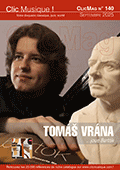 L’album s’ouvre sur le passionnant Concerto Rotondo de Giovanni Sollima (1962-), ce violoncelliste-compositeur sicilien post-minimaliste qui écrit sa première œuvre d’importance au milieu des pierres poussiéreuses et en ruines d’un espace de Palerme (Spasimo, qui donne son nom à la pièce), que son maire veut alors rendre aux habitants : étrange et multiple dans ses inspirations, le Concerto Rotondo évoque la terre, les surfaces et leurs profondeurs – et il est étrange de se rappeler que le violoncelle est ici (quasi, puisque l’électronique chahute le premier mouvement) seul. En fin de disque, Christoph Croisé sert de son jeu « délicat quoique virtuose » une deuxième pièce de Sollima (Alone), où alternent parties lentes et rapides – avant de conclure sur un morceau étincelant de Thomas Buritch (1972-), mâtiné de blues et de jazz (Some Like To Show It Off). Et, au milieu, le violoncelliste s’empare de la Sonate pour violoncelle seul de Györgi Ligeti (1923-2006) – qui en écrit le premier mouvement en amoureux éploré, dialogue entre homme et femme évoluant vers la dispute avant le calme –, à laquelle Croisé fait succéder son propre Spring Promenade, agencé pendant le confinement Covid – mis à profit pour approfondir un répertoire pour instrument solo, plutôt varié puisqu’on y retrouve aussi des œuvres des Hongrois Zoltán Kodály (1882-1967) et Péter Pejtsik (1968-, du groupe de rock progressif After Crying). (Bernard Vincken)  Modernism. Multiculturism. Multi-tuning. Lockdown. These are among the elements that bind the works on The Solo Album by award winning cellist Christoph Croisé, who took the opportunity of 2020’s coronavirus isolation to work intensively on a variety of solo works and also turn his hand to composition. At the heart of the album is Hungarian composer Zoltán Kodály’s epic Sonata, the first major work for solo cello after the suites by Johann Sebastian Bach which were written two centuries earlier. The virtuosity demands of the soloist re-tuning two of the cello’s strings, double-stop trills and simultaneous bowed and plucked passages, all of which Christoph dispatches with aplomb. Framing Kodály’s Sonata are works by two compatriots, György Ligeti’s two-movement Sonata which draws inspiration from Béla Bartók, and the more recent Stonehenge by cellist, composer and pop-music producer Péter Pejtsik which includes intimations of electric guitar. A “sandwich filler” is Christophe’s first composition for solo cello, Spring Promenade, which is infused with boogie-woogie, reggae, swing and techno. He took inspiration from Sicilian composer-cello virtuoso Giovanni Sollima whose Concerto Rotondo incorporates electronics and extended techniques. Closing out the album, Sollima’s short work Alone gives way to the album’s “encore”, the exuberant Some like to show it off by Croatian cellist-composer Thomas Buritch.
 |
